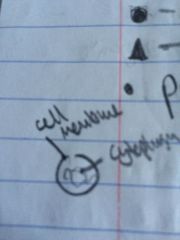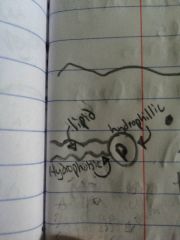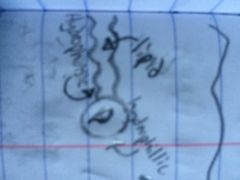![]()
![]()
![]()
Use LEFT and RIGHT arrow keys to navigate between flashcards;
Use UP and DOWN arrow keys to flip the card;
H to show hint;
A reads text to speech;
30 Cards in this Set
- Front
- Back
- 3rd side (hint)
|
Cell theory.
|
- All living things are composed of cells.
- cells are the basic structure and function of life. - cells must come from pre-existing cells. |
There are three parts to the cell theory.
|
|

Prokaryotes
|
- No cell membrane or nucleus.
- 0.2 or 2.0 in diameter - first cell |
Manly plant cells.
|
|

Eukaryotes
|
- a true cell.
- has membrane bound cells. - 10-100 in diameter. - mitosis. Has a nucleus. |
Animal cell
|
|
|
Cytoplasm
|
- the material inside the cell membrane.
- not including the nucleus. |

Is inside the cell.
|
|

Plasma membrane
|
- made up of a phospholipid bilayer that controls what goes in and out of the cell.
|

A phospholipid looks like this
|
|
|
Cell wall
|
- plant cell: made of cellulose, rigid, for protection.
|
Only in plant cells
|
|
|
Vesicle
|
- store, and transport , or digest cellular products and wast.
|
Also called the little bladder.
|
|
|
Cytoplasm
|
- gel-like substance in which organelles are suspended.
- makes up about 70% of the cell volume. |
Cell tissue
|
|
|
Lysosomes
|
- membrane bound sac of enzymes site of digestion.
- act as wast disposal for the cell |
Dissolving body
|
|
|
Ribosomes
|
- reads messenger RNA to make proteins.
- puts the proteins in the R.E.R. |
Attached to the R.E.R.
|
|
|
Rough endoplasmic reticulum
|
- network of membranes that carry proteins.
- covered in ribosome. |
Or the RER
|
|
|
Smooth endoplasmic reticulum
|
- a network of membranes involved in making lipids such as steroids, cholesterol, and fats
|
Or the SER
|
|
|
Golgi apparatus
|
- flat, membrane bound sacs that prepare and store proteins for secretion.
- packing center of the cell. |
An organelle
|
|

Mitochondria
|
This is where RESPIRATION takes place.
|
Not human.
|
|
|
Nuclear envelope
|
- phospholipid.
- protein bilayer. - surrounds the nucleus and controls what goes in and out of it. |
Part of the nucleus
|
|
|
Nucleus
|
- membrane bound structure that contains the calls hereditary info and controls the cells growth and reproduction.
|
The center of an animal cell.
|
|
|
Nucleolus
|
- the site of ribosome synthesis in the nucleus.
|
|
|
|
Chromatin
|
- long thick stands of DNA in the nucleus.
|
|
|
|
Chloroplast
|
- site of photosynthesis
|
|
|
|
Amyloplast
|
- makes and stores staro.
|
|
|
|
Vacuole
|
- stores water, wast and dissolved material.
- small in animal cell and large In plant cells. |
|
|
|
Flagella and Cilia
|
- helps the cell move.
|
|
|
|
Passive transport
|
- the movement of molecules from an area of high concentration to an area of low concentration.
|
|
|
|
Active transport
|
- using ATP to move molecules from an area of low concentration to an area of high concentration.
|
|
|
|
Diffusion
|
- the movement of a substance from a area of high concentration to an area of low concentration.
|
|
|
|
Osmosis
|
- is the diffusion of water through a selectively permeable membrane
From an area of high water potential to an area of low water potential. |
|
|
|
Isotonic
|
Cell solution is the same as the environment.
|
|
|
|
Hypertonic
|
More cells solute in the solution them in the environment.
|
|
|
|
Hypotonic
|
Less solute in the solution then in the environment.
|
|
|
|
Facilitated diffusion
|
- molecules are moved across a membrane from high to low concentration by carrier proteins
|
|

